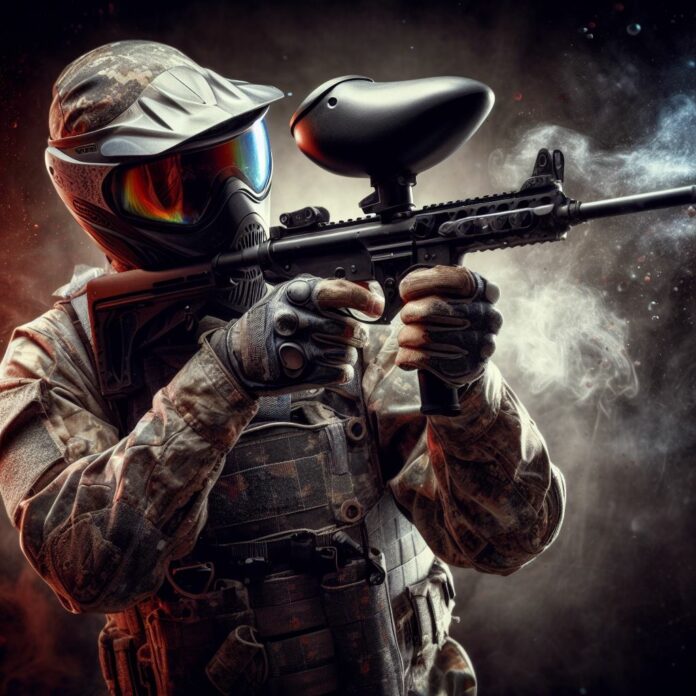Paintball guns, also known as paintball markers, are the key equipment used in the game of paintball. Understanding how these guns work is essential for any paintball enthusiast. A paintball gun operates through a combination of mechanical and pneumatic mechanisms, allowing players to propel paint-filled capsules accurately.
The components of a paintball gun include the marker body, hopper, gas source, and barrel. The marker body houses the firing mechanism, while the hopper stores the paintballs and feeds them into the firing chamber.
The gas source provides the power needed to propel the paintballs, and the barrel helps control their trajectory.
To understand how a paintball gun works, it is important to grasp the process of loading, propelling, and shooting a paintball. Loading involves placing a paintball into the firing chamber.
Propelling the paintball is achieved by utilizing compressed gas, typically CO2 or compressed air, to create enough force for the paintball to exit the barrel. Aiming and shooting are accomplished by pulling the trigger, which releases a burst of gas, forcing the paintball out of the barrel with speed and accuracy.
The role of gas in paintball guns is crucial, as it provides the necessary propulsion. Different types of gas can be used, each with its characteristics and advantages. The expansion and pressure regulation of the gas are managed by the gun’s internal mechanisms, ensuring consistent and controlled shots.
Proper maintenance and care are essential to keep a paintball gun in optimal condition. This includes regular cleaning to remove debris and paint residue, as well as maintaining the O-rings, which prevent gas leakage and ensure a secure seal.
Lastly, there are various tips and techniques that can be utilized to improve the performance of a paintball gun. These range from upgrading components to using high-quality paintballs and properly adjusting the velocity settings.
By understanding how paintball guns work and implementing proper maintenance techniques, players can maximize their equipment’s performance and enhance their paintball game experience.
Components of a Paintball Gun
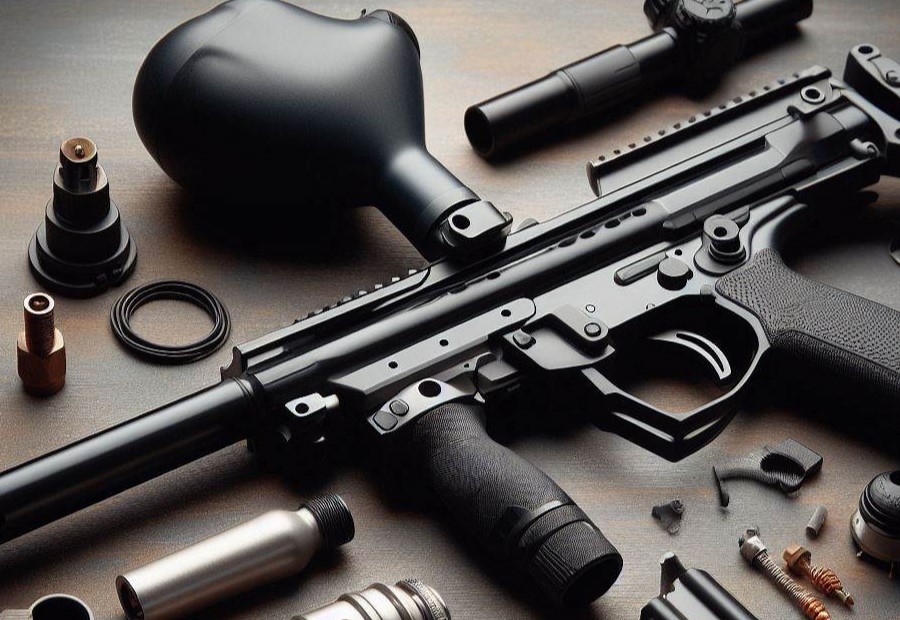
The components of a paintball gun are like the building blocks that come together to create the ultimate paintball experience. From the marker body that houses the firing mechanism to the gas source that propels each shot, and not forgetting the importance of the hopper and barrel.
In this section, we’ll explore each of these crucial components and uncover how they contribute to the functioning and performance of a paintball gun. Get ready to dive deep into the fascinating inner workings of this beloved sport!
Marker Body
| Marker Body |
| The marker body is the main component of a paintball gun. |
| It houses all the essential parts that make the gun function. |
| The body is typically made of durable materials such as aluminum or composite materials. |
| It provides the structure and support for the other components. |
| Some marker bodies are designed with ergonomic features for better handling and comfort. |
- When choosing a paintball gun, consider the quality and construction of the marker body.
- Look for a solid and well-built marker body that can withstand the rigors of the game.
- Ensure that the marker body is compatible with other components and accessories that you may want to use.
- A well-designed marker body can improve your overall paintball gun performance and enhance your gaming experience.
- Take care of your marker body by cleaning it regularly and following proper maintenance procedures.
By paying attention to the marker body, you can ensure that your paintball gun is reliable, durable, and performs optimally during games.
Hopper
The hopper, an essential component of a paintball gun, is responsible for holding and feeding the paintballs into the marker. Let’s explore how the hopper works:
- To load the hopper, you can either open the lid or detach it from the marker.
- Pour the paintballs into the hopper and securely close the lid.
- When the paintball gun fires, it generates air pressure that propels the paintball downward into the marker.
- The hopper utilizes gravity to feed the paintballs into the marker’s chamber.
- After each paintball is fired, the hopper releases the next paintball into position for firing.
The design of the hopper is crucial in ensuring a consistent and smooth feeding of paintballs into the marker. It usually consists of a feed neck that attaches to the marker body and a motorized or gravity-fed mechanism to control the paintball flow.
To maintain optimal performance, it is important to properly care for the hopper. Regularly cleaning the hopper and inspecting it for any damage or obstructions is necessary to prevent jams or misfeeds.
Gas Source
| Gas Source |
| The gas source is an essential component for propelling paintballs in a paintball gun. It provides the necessary energy to shoot the paintballs at high velocities. |
| CO2 (carbon dioxide) and compressed air (also known as HPA – high-pressure air) are the two most commonly used gas sources in paintball guns. These gases are stored in tanks that can be attached to the paintball gun. |
| CO2 tanks contain liquid carbon dioxide, which expands into gas when released into the gun. On the other hand, compressed air tanks store pressurized air that is regulated before entering the gun. |
| The choice of gas source can impact the performance of the paintball gun. CO2 is generally less consistent compared to compressed air and can cause fluctuations in velocity, especially in cold temperatures. Experienced players generally prefer compressed air due to its more consistent velocities. |
| Proper maintenance and refilling of the gas source are important to ensure reliable performance. CO2 tanks need to be refilled when empty, while compressed air tanks can be refilled at a paintball pro shop or using a personal compressor. |
Barrel
The barrel is an essential component of a paintball gun. The barrel plays a crucial role in the performance of a paintball gun. A longer barrel can improve accuracy and shooting distance.
An important factor in a paintball gun’s performance is the barrel’s length and bore size. Barrel bore size determines the fit of the paintball. A tighter bore size can lead to increased efficiency in propelling the paintball.
A loose bore size can accommodate varying paintball sizes. Choosing the right barrel for your playing style and paint type is vital. Regular cleaning and maintenance of the barrel is essential for optimal performance.
Fact: The accuracy of a paintball gun is influenced by the barrel length, bore size, and paint quality. Selecting a suitable barrel and properly maintaining it can enhance shooting accuracy and overall performance.
How Does a Paintball Gun Work?
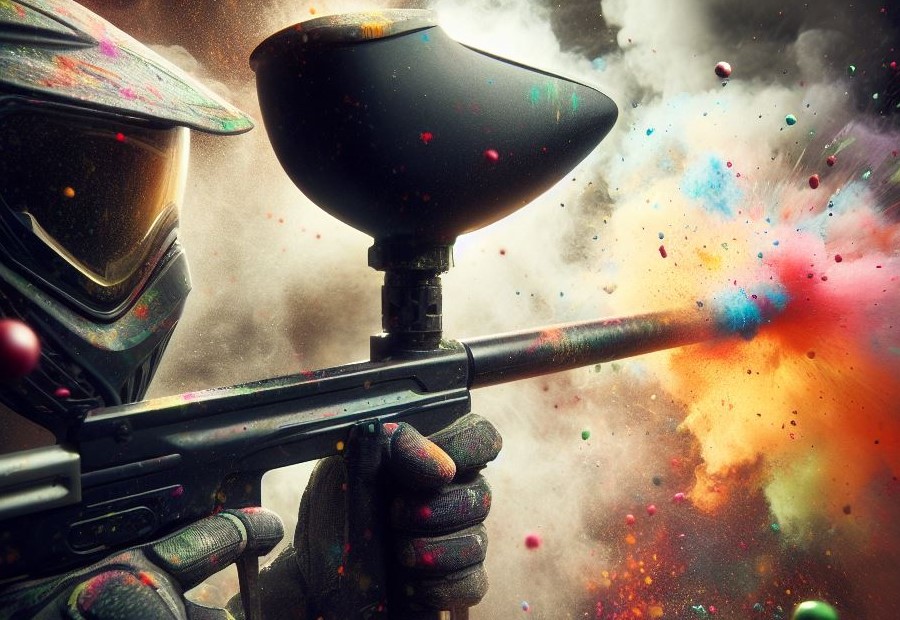
Curious about how a paintball gun works? Get ready to dive into the inner workings of this adrenaline-inducing device. In this section, we’ll unveil the secrets behind loading the paintball, propelling it with power, and mastering the art of aiming and shooting.
Buckle up and prepare to discover the fascinating mechanics that make every paintball game an exhilarating experience. Let’s explore the exciting world of paintball guns!
Loading the Paintball
To ensure proper functioning of the paintball gun, it is important to follow these steps when loading the paintball:
- Start by opening the hopper lid or access panel.
- Carefully pour the paintballs into the hopper, ensuring that they are aligned with the feed neck.
- Securely close the hopper lid or access panel to prevent any paintballs from spilling out.
- Take a moment to verify that the paintballs are properly seated in the hopper, ensuring that none are stuck or jammed.
- If you are using a magazine-fed paintball gun, insert the magazine and lock it into place.
For optimal performance and reliability, there are a few suggestions to consider:
- It is recommended to use high-quality paintballs that are the appropriate size for your paintball gun. This will help prevent jams.
- Avoid overloading the hopper, as this can lead to feeding issues.
- Regularly inspect the hopper to ensure it is clean and free from any debris that could interfere with the paintball feed.
- Keep the hopper and paintballs dry to prevent swelling or clumping.
Propelling the Paintball
The propelling of a paintball is achieved through the use of compressed air or CO2 stored in a gas tank. When the trigger is pulled, a burst of gas is released from the tank into the firing chamber of the paintball gun.
This sudden release of gas creates a high-pressure environment in the gun, which propels the paintball forward. The gas pushes against a small metal piston, which in turn pushes the paintball out of the barrel with a high velocity.
The speed at which the paintball is propelled can be adjusted by regulating the amount of gas released and the pressure at which it is released. A higher pressure will result in a faster and more powerful shot, while a lower pressure will result in a slower and less powerful shot.
The direction and accuracy of the propelling can be controlled by the player’s aim and the design of the barrel. The paintball will continue to travel until it hits a target or loses its momentum.
It is important to note that the propelling of a paintball should be done responsibly and within the rules and regulations of the game to ensure safety.
Aiming and Shooting
When it comes to aiming and shooting with a paintball gun, there are several important steps to follow:
- Hold the gun properly: Ensure a firm grip on the gun, keeping it steady and balanced.
- Align your body: Position yourself in a way that allows for stability and a clear line of sight towards the target.
- Focus on the target: Concentrate your gaze on the specific point you want to hit.
- Aim using the sights: Utilize any sights or visual aids on the gun to help aim accurately.
- Adjust for distance: Take into account the distance between you and the target, adjusting your aim accordingly.
- Control your breathing: Take slow, steady breaths to minimize any movement and maintain stability while aiming.
- Pull the trigger smoothly: Slowly squeeze the trigger to ensure a steady shot, avoiding any jerking or sudden movements.
- Follow through: Keep your focus on the target after firing to assess your shot and make any necessary adjustments for the next one.
By following these steps, you can improve your aiming and shooting accuracy with a paintball gun.
The Role of Gas in Paintball Guns
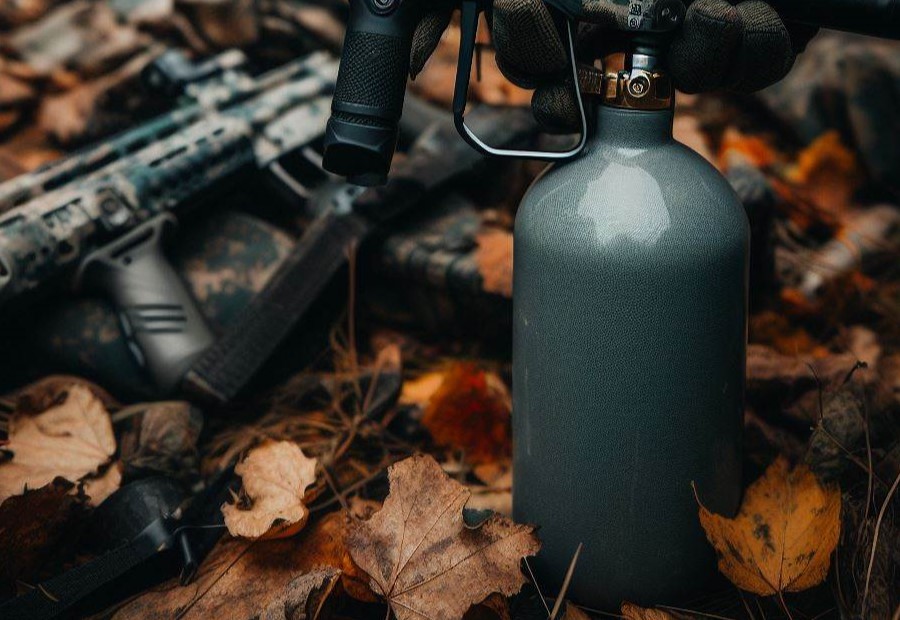
Gas is a crucial component that powers the exhilarating game of paintball. In this section, we will uncover the secrets behind the role of gas in paintball guns. Get ready to dive into the world of high-pressure propulsion as we explore the types of gas used and the fascinating concepts of gas expansion and pressure regulation.
Prepare to be amazed by the science behind every shot and gain a deeper understanding of how paintball guns work.
Types of Gas Used
When it comes to paintball guns, there are various types of gas used to power them. Below is a table that provides information about the commonly used types of gas in paintball:
| Type of Gas Used | Description |
| CO2 (Carbon Dioxide) | CO2 is commonly used in paintball guns. It is easily accessible and affordable. CO2 is stored as a liquid and expands into gas when released, providing propulsion for the paintball. |
| Compressed Air or Nitrogen | Compressed air or nitrogen is increasingly popular in paintball. It is stored in high-pressure tanks and offers a more consistent and reliable source of power compared to CO2. |
When selecting the type of gas for your paintball gun, consider factors such as availability, affordability, and the specific requirements of your marker. Some markers are designed to work better with CO2, while others perform optimally with compressed air or nitrogen.
It is essential to consult your marker’s user manual or seek advice from experienced players or professionals to determine which type of gas is best for your gun.
Remember to follow safety guidelines and properly store and handle gas cylinders to ensure a safe and enjoyable paintball experience.
Gas Expansion and Pressure Regulation
Gas expansion and pressure regulation are essential elements in the operation of paintball guns. When a paintball gun is fired, the gas inside the gun undergoes expansion, which in turn propels the paintball forward. The pressure regulation system built into the gun controls this expansion process.
Paintball guns can utilize different types of gas, such as CO2 or compressed air, each of which affects the process of gas expansion and pressure regulation. When CO2 gas is released, it rapidly expands, resulting in a higher initial pressure.
On the other hand, compressed air provides a more consistent pressure throughout the duration of the shot.
The purpose of pressure regulation is to ensure that the gas expands at an appropriate rate to propel the paintball accurately and with the desired force. By adjusting the pressure of the gas as it enters the firing chamber, the regulator allows for precise control over the speed and distance that the paintball can travel.
Gas expansion and pressure regulation play a vital role in maintaining the accuracy and consistency of paintball shots. Proper regulation guarantees that each shot possesses the same force and trajectory, enabling players to aim and hit their targets with confidence.
For players aiming to optimize their performance on the field, understanding gas expansion and pressure regulation in paintball guns is crucial. By selecting the suitable gas and properly maintaining the regulator, players can ensure that their shots are consistently reliable throughout their gameplay.
Maintenance and Care of Paintball Guns
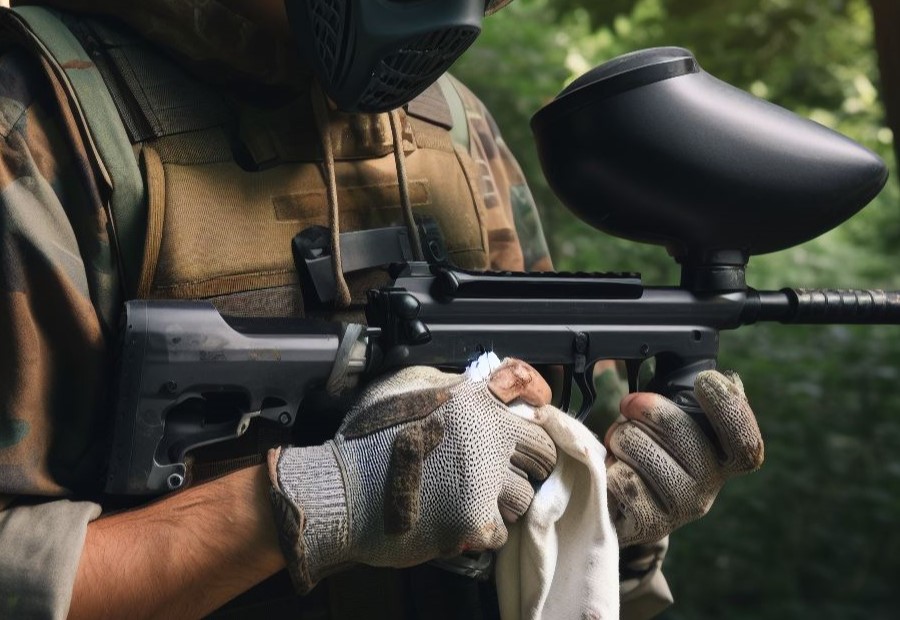
Taking care of your paintball gun is essential to ensure optimal performance on the field. In this section, we’ll dive into the key aspects of maintenance and care that every paintball player should prioritize.
From cleaning the marker to O-ring maintenance, we’ll explore the tips and techniques necessary to keep your paintball gun in top-notch condition. Say goodbye to jammed barrels and leaky O-rings as we unveil the secrets to a well-maintained paintball marker.
Cleaning the Marker
When it comes to cleaning the marker of a paintball gun, it is important to follow these steps to ensure proper maintenance and performance:
- Disassemble the marker: Carefully take apart the different components of the marker, including the barrel, hopper, and gas source. Ensure that any stored pressure has been released.
- Clean the barrel: Use a squeegee or barrel swab to remove any paint residue or debris from the barrel. Gently scrub the inside of the barrel to ensure a clean surface.
- Remove and clean the hopper: Take off the hopper and empty any remaining paintballs. Use a soft cloth or sponge to clean the inside and outside of the hopper, removing any paint or dirt.
- Clean the gas source: If using a CO2 tank, ensure the tank is empty and then detach it from the marker. Wipe the tank with a damp cloth to remove any dirt or grime. For compressed air tanks, check the manufacturer’s instructions for proper cleaning.
- Clean the marker body: Use a soft cloth or sponge to wipe down the marker body, removing any paint or dirt. Pay attention to any small crevices or areas that may require extra cleaning.
- Reassemble the marker: Once all the components are clean and dry, carefully put the marker back together, ensuring that everything is securely attached.
- Perform a test fire: Before using the marker again, perform a test fire to ensure it is functioning properly and shooting accurately.
Regularly cleaning the marker is crucial to maintain its performance and prolong its lifespan. It helps prevent paint build-up, leaks, and malfunctions, ensuring a smooth and enjoyable paintball experience.
O-Ring Maintenance
O-Ring maintenance is a crucial step in taking care of your paintball gun to guarantee optimal performance. Here are the necessary steps for effectively maintaining the O-Rings:
- Regularly inspect the O-Rings: Make it a habit to frequently check for any signs of wear or damage on the O-Rings. Look out for cracks, tears, or areas that have become flattened.
- Thoroughly clean the O-Rings: Use a soft lint-free cloth to gently wipe the O-Rings clean. Avoid the use of harsh chemicals or solvents that may harm the rubber.
- Properly lubricate the O-Rings: To keep the O-Rings moisturized and flexible, apply a small amount of paintball-specific lubricant. Ensure that the lubricant you use is compatible with rubber O-Rings.
- Distribute the lubricant evenly: Carefully spread the lubricant over the O-Rings using your fingers or a cotton swab. It is important to guarantee that all the O-Rings are evenly coated.
- Reassemble the paintball gun: Once the O-Rings are cleaned and lubricated, skillfully reassemble the different components of the paintball gun.
Tips for Improving Paintball Gun Performance
- To improve your paintball gun performance, it is essential to clean it regularly. Make sure to remove any dirt or debris that may interfere with the gun’s mechanisms.
- Checking and replacing worn or damaged O-rings is crucial. These small rubber seals help create a tight seal between gun parts and prevent leaks that can impact performance.
- Using high-quality paintballs that are the correct size for your gun is important. Cheap or poorly made paintballs can easily break and affect accuracy.
- Properly adjusting the velocity of your gun is key. This ensures that paintballs are consistently fired at the right speed, improving accuracy and preventing breakage inside the gun.
- Consider upgrading your barrel for better performance. Look for barrels with rifling or porting, as they can enhance accuracy and range.
- Invest in a reliable CO2 or compressed air tank to provide a consistent flow of air, as it is crucial for propelling the paintballs effectively.
- Using a quality hopper or loader is important. It ensures smooth and reliable feeding of paintballs, preventing jams and maintaining a consistent rate of fire.
- Dedicate time to practicing your shooting technique. Improving your aim and control will greatly impact your performance on the field.
Frequently Asked Questions
How does a paintball gun work?
A paintball gun, also known as a marker, uses compressed gas, usually CO2 or air, to propel paintballs. When the trigger is pulled, a series of mechanisms is activated that release the compressed gas, shooting out the paintball.
What are the main types of paintball guns?
The main types of paintball guns are mechanical and electronic. Mechanical guns need to be manually cocked for each shot and can only fire single shots. Electronic guns can automatically fire paintballs according to the firing mode set and are more accurate and consistent.
What are the differences between an electronic and a mechanical paintball gun?
An electronic paintball gun is powered by a battery and has an electronic circuit board that controls the firing cycle. It can fire continuously without the need to reload. A mechanical paintball gun is manually cocked and requires chambering for each shot, resulting in slower firing and single shots.
How does the firing mechanism of a paintball gun work?
The firing mechanism of a paintball gun involves a series of events. When the trigger is pulled, it activates a sear, releasing the compressed gas which shoots out the paintball. The sear then moves back into place, allowing the gun to be ready to fire again.
What type of gas is used in paintball guns?
Paintball guns use compressed gas, usually CO2 or air, to propel the paintballs. CO2 is commonly used in recreational paintball, while air is more common in competitive play due to its consistent performance and ability to adjust velocity accurately.
Is it safe to use a paintball gun?
While paintball guns are generally considered safe, it is important to wear proper protective gear, including goggles and body armor, to prevent injuries. Paintballs can still cause bruises and players should follow safety guidelines and rules to ensure a safe and enjoyable experience.

